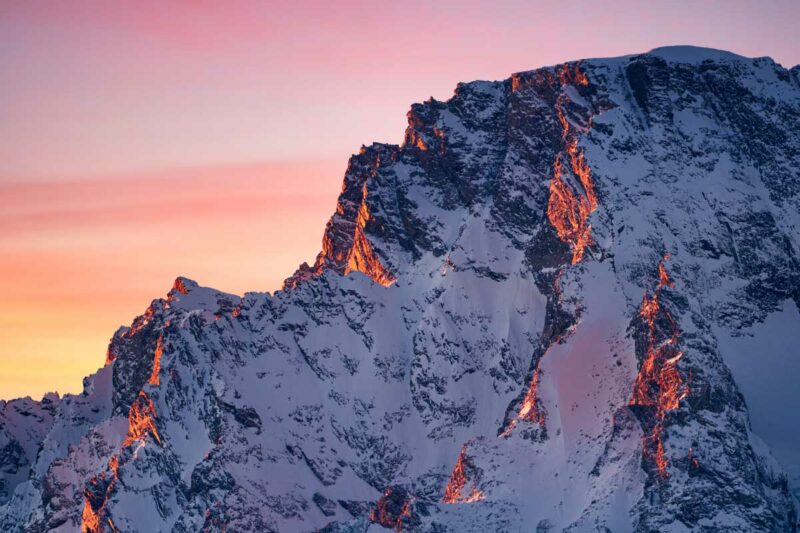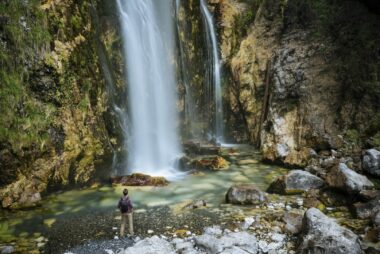Table of Contents Show
Wyoming mountains are some of the most stunning mountains in the country. From the majestic Grand Teton Range to the beautiful Wind River Range, there are plenty of breathtaking sights to see here.
We’re pretty confident these Wyoming mountain ranges will blow you away, so let’s learn more about them and how to visit!
Which Mountain Chain Runs Through Wyoming?
Wyoming is a veritable paradise for outdoor enthusiasts, and one of the primary attractions is the state’s stunning mountain ranges. They include the famous Rocky Mountains, extending from Northern Alberta in Canada to New Mexico.
The Rocky Mountains are home to several ranges, including the Absaroka Range, Bighorn Mountains, Snowy Range, Teton Range, Northern Wind River Range, and the Wyoming Range.
Wyoming mountains have the second-highest average elevation in the U.S. They are worth exploring and offer unique activities and sights.
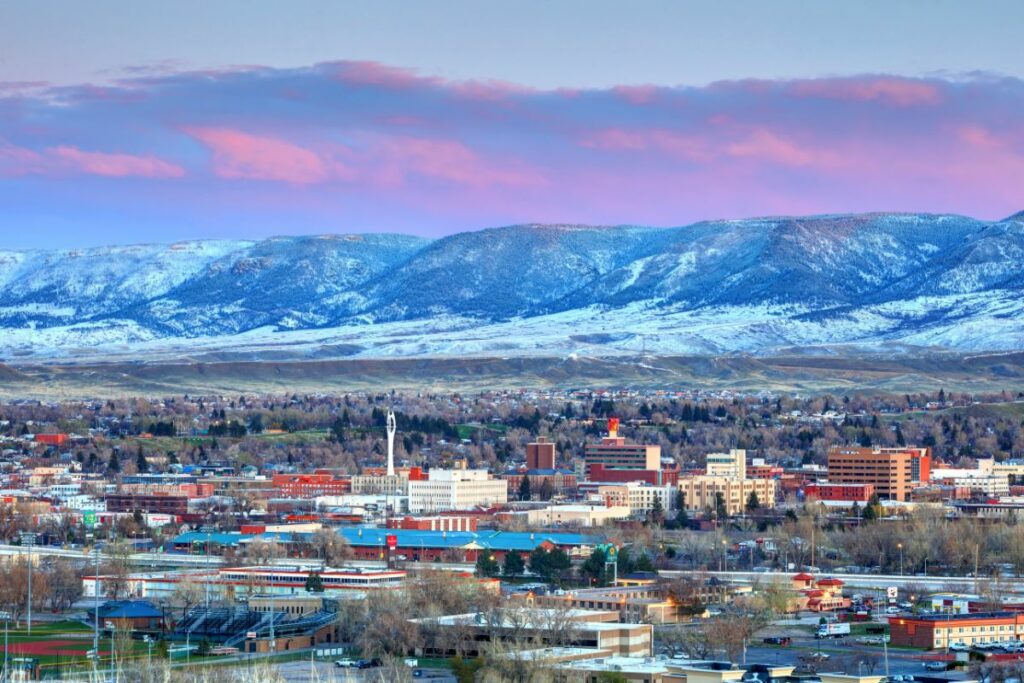
Whether you’re looking for a scenic drive, a challenging hike, or a place to enjoy some winter sports, Wyoming’s mountains have something for everyone. So if you’re planning a trip to Wyoming, add time in the mountains to your itinerary.
What Parts of Wyoming Are Mountainous?
But where should your itinerary take you? Most of Wyoming’s mountains are in western Wyoming, but you can find them throughout the state.
The Bighorns are in North Central Wyoming, and you’ll find the Snowy Range in the southeast corner near Laramie. Wherever your Wyoming travels take you, the mountains will be there.
These Wyoming Mountain Ranges Will Blow You Away
All of Wyoming’s mountain ranges will blow you away, but the Teton Range and the Northern Wind River Range are two of the most stunning in Wyoming and the U.S.
They’re home to some of Wyoming’s tallest peaks and jaw-dropping scenery. You won’t regret exploring these two Wyoming mountain ranges.
Teton Range
The Teton Range towers above the famous Jackson Hole Valley, its serrated edges seeming to come out of the earth with no foothills. This range is a renowned destination for hikers, climbers, and skiers, who come to enjoy the breathtaking views and challenging terrain.
The Teton Range is a subrange of the Rocky Mountains that extends approximately 40 miles across northwestern Wyoming. The range is home to 84 named mountains, with the Cathedral Group the most well-known.
This group contains eight of the ten highest summits in the Wyoming Range. Grand Teton is the highest peak at 13,775 feet, and there are eight peaks over 12,000 feet in this range.

How to Explore the Range: The Jackson Hole Airport is in Grand Teton National Park, making it a convenient place to fly into if you want to explore these Wyoming mountains. If you have the proper vehicle, you can arrive from the northeast via Moran and Highway 26.
Once in the park, there are many activities to keep you busy. You can hit the slopes at Jackson Hole Mountain Resort or Grand Targhee or go for a hike at String or Jenny Lake. Take the Jenny Lake Ferry to get further into the mountains and explore hundreds of miles of hiking trails. Or pay a visit to the nearby Bridger-Teton National Forest for more trails and scenic views.
If climbing is your pleasure, there are numerous options for many levels of climbers. Check in at the Jenny Lake Ranger Station for all the available climbing routes.
If you’re more into backpacking, the backcountry 40-mile Teton Crest Trail runs through the Tetons, along with the Snake River, for rafting and fishing adventures. With many lodging options, from primitive camping and RV sites to charming lodges and cabins, staying here is easy.
Northern Wind River Range
Wyoming is home to some of the most beautiful mountains in the United States. The Northern Wind River Range is a prime example. Spires and jagged edges create a fairytale-like beauty, and glaciers add to the majestic scenery.
The range includes 2.25 million acres, two national forests, and three wilderness areas.
The Continental Divide spans 100 miles and is a popular destination for hikers and outdoor enthusiasts. This Wyoming mountain range is also home to Wyoming’s tallest peak, Gannett Peak (13,802 feet) includes the Wind River Indian Reservation.

How to Explore the Range: Access to the Northern Wind River Range is through Pinedale, Dubois, Lander, and Riverton.
Backpacking is a popular activity here, and you can hike along some of the trails in the Titcomb Basin and Cirque of the Towers. Hiking to Pop Agie Falls in Sinks Canyon State Park is another popular excursion.
With 2,000 miles of rivers and 626 lakes and reservoirs, it’s no wonder the fishing is some of the best in the region. You can’t forget about whitewater rafting, canoeing, and kayaking.
The granite walls and spires offer climbing for all abilities, from beginners to more advanced technical climbers. There are many options for camping, with full-service and primitive sites near the range and within two state parks.
The Wind River Range is also home to the White Pine Ski Area, so winter sports are another excellent way to explore this stunning Wyoming mountain range with over 40 peaks reaching beyond 13,000 feet.
What Are the Major Mountains in Wyoming?
With 36 mountain peaks in Wyoming as 13’ers (at least 13,000 feet in elevation but less than 14,000 feet), there are some major mountains in this beautiful state. While you can only experience many via intense hiking, all are majestic.
We’ve listed the top five highest peaks in Wyoming below. Are you ready for the adventure?
Gannett Peak
Wyoming is home to some of the most beautiful mountains in the country, and Gannett Peak is no exception.
Sitting in the Northern Wind River Mountain Range on the Continental Divide Trail, this 13,804-foot peak is Wyoming’s highest. The 896-acre Gannett Glacier is the largest single glacier in the American Rocky Mountains.
Accessing Gannett Peak is not for the faint of heart. It is an authentic backcountry experience, and many take 3-5 days to complete the hike. This is an advanced trail you can access from several points, with the most popular starting point near Dubois, Wyoming, on the Glacier Trail.
There are glacial crossings, and you must climb rocks and snow. If you have the skills and the heart, this climb is worth the effort. If your hiking skills are more worthy of an hour or two, set your sights on one of Wyoming’s many other trails to access the mountain views.
Grand Teton
The Grand Teton is one of the most popular and accessible Wyoming mountains to climb. At 13,770 feet, it’s a challenging but fun summit and is the second highest peak in the state.
The views from the top are breathtaking, and the 7,700-foot elevation difference between the peak and the Gros Ventre Valley makes it a photogenic mountain. However, you need to be an experienced climber to embark upon one of the 35 routes to the summit.
Keep in Mind: Have you heard of the Yellowstone Zone of Death? See why you should avoid this area!
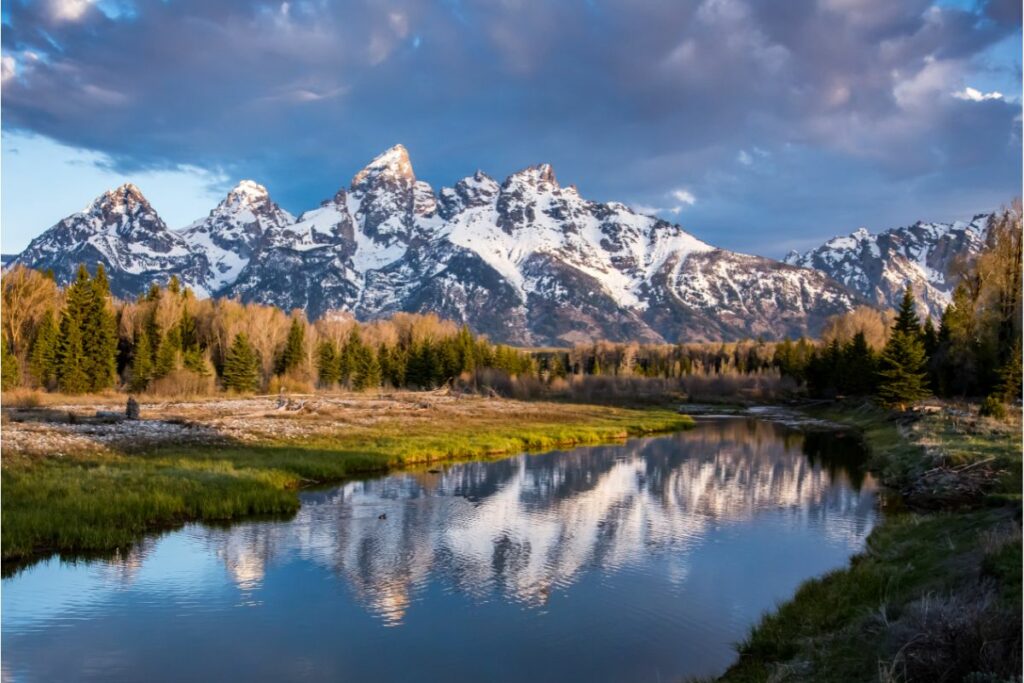
Are you not that adventurous but still want to experience the beauty of the Grand Teton and the rest of the mountain range? Hop in your car and take a drive through Grand Teton National Park.
You can choose from several scenic drives that can get you to the beauty of the Wyoming mountains without the effort of climbing them. These include Jenny Lake Scenic Drive, Signal Mountain Summit Road, and Teton Park Road.
Fremont Peak
Fremont Peak is the third highest peak in the state at 13,751 feet. While climbing this peak doesn’t require technical skills or specific climbing gear, it is still a 20-hour average backpacking trip.
Elkhart Park Trailhead is one of the popular access points to Fremont Peak. From the trailhead, you start on the Pole Creek Lakes Trail. Within four miles of hiking, you’ll have amazing views of Fremont Peak. If that is all you need, you have created an epic day hike.
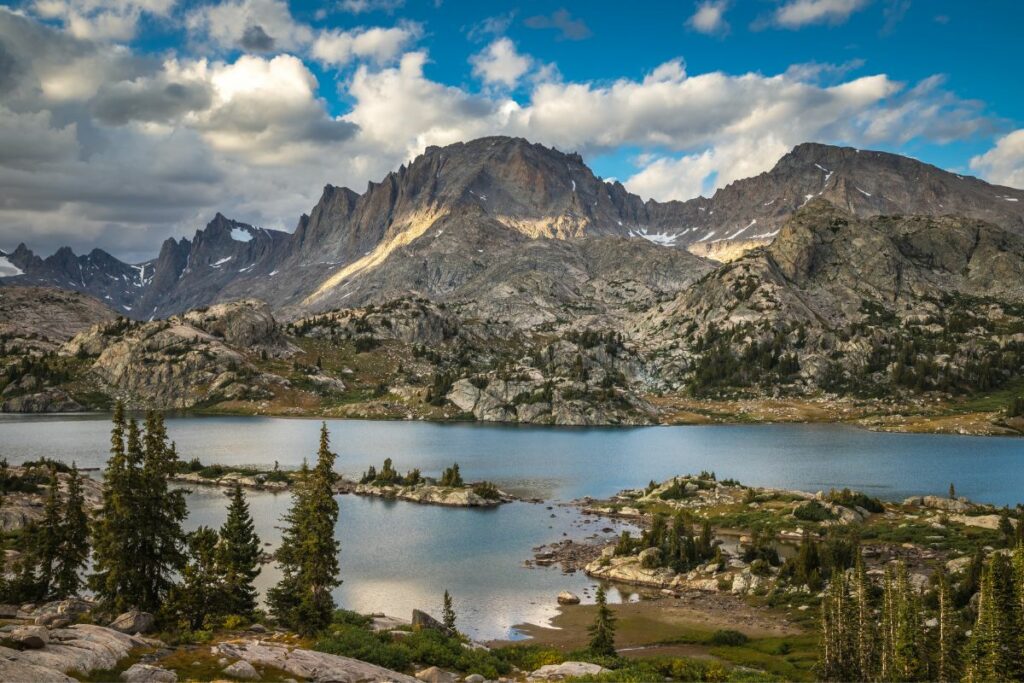
However, if you like to summit peaks, your adventure has only begun. This 36-mile out and back trail will send you past gorgeous lakes, stunning mountain vistas, and craggy, rocky paths. Once to the top, the world opens up to the peaks within the Northern Wind River Range.
Mount Warren
Also, in the Northern Wind River Range, Mount Warren is Wyoming’s fourth highest peak at 13,722 feet. Not nearly as popular as Wyoming’s other three tallest peaks, it is still majestic and requires backpacking and extensive hiking experience.
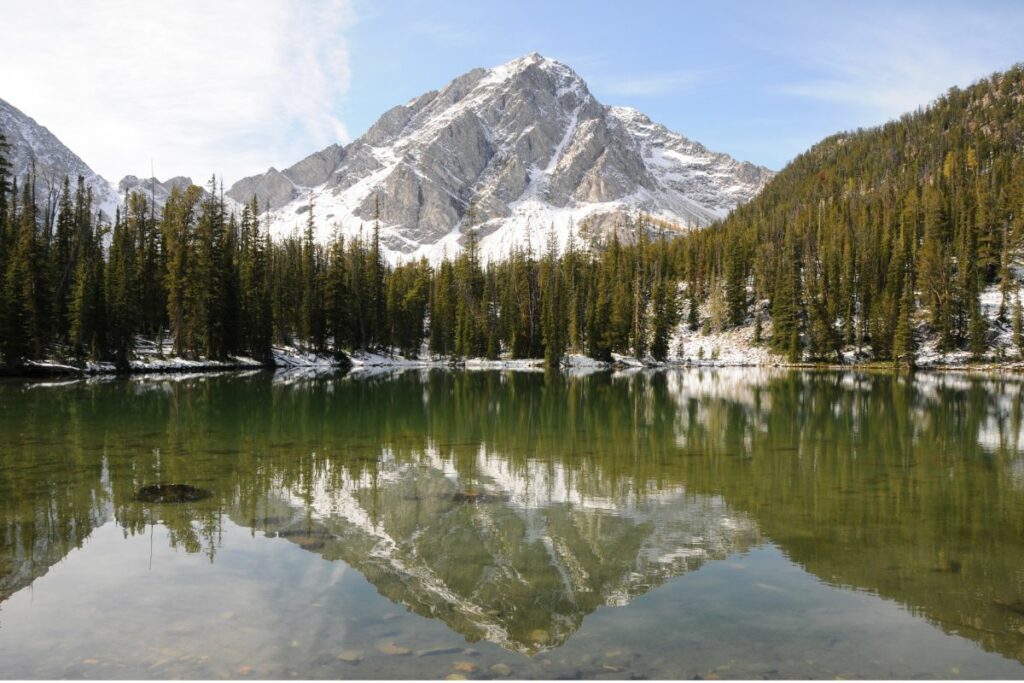
Sitting at the heads of Dinwoody Glacier, Helen Glacier, and Titcomb Basin, there are no direct access points to hike and summit this Wyoming mountain peak. However, some routes are becoming easier to access as more and more people ascend this peak yearly.
Knowing this, the best place to access Mount Warren is the Elkhart Park Trailhead, approximately 14 miles from Pinedale. You’ll hike the Pole Creek Trail as though you were hiking from Fremont Peak to Island Lake.
You will turn off there to head toward Mount Warren. However, Mount Warren will not come into view until you are at its base.
Keep in Mind: After you’re done exploring the Wyoming mountains, relax at one of these Hot Springs!
Mount Helen
Wyoming’s fifth highest peak is Mount Helen in the Bridger-Teton National Forest. It is 13,620 feet and is also in the Northern Wind River Range.
Like Mount Warren and Fremont Peak, whether you’re interested in hiking the area or bagging the peak, you’ll still start at the Elkhart Park Trailhead near Pinedale. Hike the Pole Creek Trail to Island Lake. You’ll eventually take the Titcomb Basin Trail toward Mount Helen.
There are several ways to access Mount Helen, but all involve some climbing and possibly technical skills, alongside a multi-day backpacking trip. No matter the route, you will be rewarded at the end with views of the peaks in the Northern Wind River Range.
Are Wyoming Mountains Worth Visiting?
To see these Wyoming mountain peaks up close, you’ll need to embark upon a multi-day backpacking trip. Even if you don’t plan on seeing all the peaks, hiking on the trails that get you closer to them takes some effort.
So whether you catch the views by car, by a day hike, or via a multi-day, summit-climbing backpacking trip, Wyoming mountains are worth every effort it takes to get there, even if that effort is only planning your next road trip to Wyoming.
Would you take the challenge of a multi-day hike in the Wyoming mountains?




